History of South Australia
Part of a series on the |
||||||||||||||||||
|---|---|---|---|---|---|---|---|---|---|---|---|---|---|---|---|---|---|---|
| History of Australia | ||||||||||||||||||
 | ||||||||||||||||||
| Chronological | ||||||||||||||||||
| By topic | ||||||||||||||||||
| By region | ||||||||||||||||||
|
||||||||||||||||||
|
| ||||||||||||||||||
The history of South Australia refers to the history of the Australian State of South Australia and its preceding Indigenous and British colonial societies. Aboriginal Australians have lived in South Australia for tens of thousands of years, while British colonists arrived in the 19th century to establish a free colony, with no convict settlers. European explorers were sent deep into the interior, discovering some pastoral land but mainly large tracts of desert terrain.
The colony became a cradle of democratic reform in Australia. The Parliament of South Australia was formed in 1857, when the colony was granted self-government. Women were granted the vote in the 1890s. South Australia became a State of the Commonwealth of Australia in 1901 following a vote to federate with the other British colonies of Australia. While it has a smaller population than the eastern States, South Australia has often been at the vanguard of political and social change in Australia.
Aboriginal settlement
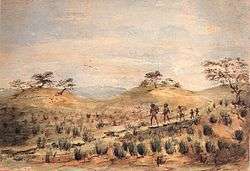
The first people to occupy the area now known as South Australia were Australian Aborigines. Their presence in northern Australia began around 40,000 to 60,000 years ago with the arrival of the first of their ancestors by land-bridge from what is now Indonesia. Their descendants moved south and, though never large in numbers, occupied all areas of Australia, including the future South Australia.[1]
Evidence for human activity in South Australia dates back more than 65,000 years ago with ceremonial sites and rock art in the Flinders Ranges and flint mining activity and rock art in the Koonalda Cave on the Nullarbor Plain. In addition wooden spears and tools were made in an area now covered in peat bog in the South East. Kangaroo Island was inhabited long before the island was cut off by rising sea levels. Temporary campsites in the Roxby dunefields have been dated to 19,000 years ago, and Aboriginal people have continuously occupied South Australia deserts since that time.[2]
By the time immediately prior to the British settlement of Australia, there were a large number of distinct societies and language groups in what is now South Australia. It is possible to speak of at least two dominant cultures present in South Australia prior to European contact, although there were many distinct societies within each of these cultures. The first was dubbed the "Lakes Group" by early anthropologists Elkin and Howitt. The "Lakes Group" culture stretches north of the Mount Lofty Ranges, up into the Flinders Ranges to around Lake Eyre, and across the Eyre Peninsula. This cultural grouping spoke at least somewhat mutually intelligible languages, which are known collectively as Thura-Yura languages. They also shared rituals. The second major group was (and remains) the "Western Desert group", or the Western Desert cultural bloc. This group of cultures encapsulates the land north and west of Lake Eyre, and the land west of the Eyre Peninsula. It extends well beyond South Australia into Western Australia and the Northern Territory. The Western Desert cultures speak largely mutually intelligible languages, so much so that some linguists believe the separate languages should be called dialects of a wider "Western Desert language". These languages are among the healthiest Aboriginal languages in modern Australia, including Pitjantjatjara and Yankunytjatjara. Many other cultures existed in South Australia at this time that do not fit neatly into the above groupings, such as the various societies that had been established along the River Murray, as well as the Ngarrindjeri of the Coorong and Lake Alexandrina area, and the various societies that existed to the southeast.
European exploration
The first recorded European sighting of the South Australian coast was in 1627 when the Dutch ship 't Gulden Zeepaerdt (The Golden Seahorse), skippered by François Thijssen, examined the coastline. Thijssen named his discovery "Pieter Nuyts Land", after the highest ranking individual on board.
In 1801–02 Matthew Flinders led the first circumnavigation of Australia aboard HMS Investigator, a Royal Navy survey ship. French Captain Nicolas Baudin was also on a survey mission in 1802, independently charting the southern coast of the Australian continent with the French naval ships the Géographe and the Naturaliste.
The British and French expeditions sighted each other, and despite France and Britain being at war at the time, they met peacefully at Encounter Bay to the south east of the Fleurieu Peninsula.
Baudin referred to the land as "Terre Napoléon". On the same voyage, Baudin named the Fleurieu Peninsula after Charles Pierre Claret de Fleurieu, a French explorer and statesman. In 1802 Flinders named Mount Lofty but recorded little of the area which is now Adelaide. Both missed the Port Adelaide River inlet, whose position was first accurately located and charted by William Light in 1836.
Charles Sturt led an expedition from New South Wales in 1829, which followed first the Murrumbidgee River into a 'broad and noble river', which he named the Murray River. His party then followed this river to its junction with the Darling River and continued down river on to Lake Alexandrina, where the Murray meets the sea in South Australia. Suffering greatly, the party had to then row back upstream hundreds of kilometres for the return journey.[3]
British preparation for establishing a colony

A group in Britain led by Edward Gibbon Wakefield were looking to start a colony based on free settlement rather than convict labour. Wakefield suggested that instead of granting free land to settlers as had happened in other colonies, the land should be sold. The money from land purchases would be used solely to transport labourers to the colony free of charge, who were responsible and skilled workers rather than paupers and convicts. Land prices needed to be high enough so that workers who saved to buy land of their own remained in the workforce long enough to avoid a labour shortage.
In 1830 Charles Sturt explored the Murray River and was impressed with what he briefly saw while passing through Lake Alexandrina, later writing:
Hurried …as my view of it was, my eye never fell on a country of more promising aspect, or of more favourable position, than that which occupies the space between the lake and the ranges of St. Vincent's Gulf, and, continuing northerly from Mount Barker, stretches away, without any visible boundary.
— Charles Sturt, Expeditions into Southern Australia[4]
Captain Collet Barker, sent by New South Wales Governor Ralph Darling, conducted a more thorough survey of the area in 1831, as recommended by Sturt. After swimming the mouth of the Murray River, Barker was killed by natives who may have had contact with sealers and escaped convicts in the region. Despite this, his more detailed survey led Sturt to conclude in his 1833 report:
…it would appear that a spot has, at length, been found upon the south coast of New Holland, to which the colonist might venture with every prospect of success, and in whose valleys the exile might hope to build for himself and for his family a peaceful and prosperous home. All who have ever landed upon the eastern shore of St. Vincent's Gulf, agree as to the richness of its soil, and the abundance of its pasture.
— Charles Sturt, Expeditions into Southern Australia[5]
South Australian Association
In 1834 the South Australian Association, with the aid of such figures as George Grote, William Molesworth and the Duke of Wellington persuaded British Parliament to pass the South Australia Act, 1834. The Act stated that 802,511 square kilometres would be allotted to the colony and to be convict-free. The plan for the colony to be the ideal embodiment of the best qualities of British society, that is, no religious discrimination or unemployment. The province and its capital were named prior to settlement. The Act further specified that it was to be self-sufficient; £20,000 surety had to be created and £35,000 worth of land had to be sold in the new colony before any settlement was permitted. These conditions were fulfilled by the close of 1835.
While New South Wales, Tasmania and (although not initially) Western Australia were established as convict settlements, the founders of South Australia had a vision for a colony with political and religious freedoms, together with opportunities for wealth through business and pastoral investments. The South Australia Act [1834] reflected these desires and included a promise of representative government when the population reached 50,000 people. South Australia thus became the only colony authorised by an Act of Parliament, and which was intended to be developed at no cost to the British government. Transportation of convicts was forbidden, and 'poor Emigrants', assisted by an Emigration Fund, were required to bring their families with them.[6] Significantly, the 1836 Letters Patent enabling the South Australia Act included a guarantee of the rights of 'any Aboriginal Natives' and their descendants to lands they 'now actually occupied or enjoyed'.[7]
The western and eastern boundaries of the colony were set at 132° and 141° East of Greenwich, and to the north at the Tropic of Capricorn, (23° 26′ South).[8] The western and eastern boundary points were chosen as they marked the extent of coastline first surveyed by Matthew Flinders in 1802 (Nicolas Baudin's priority being ignored).[9]
In 1836, the John Pirie and the Duke of York of the South Australia Land Company set sail for South Australia to establish the first settlement on Kangaroo Island.
Proclamation of South Australia (1836)
| Province of South Australia | |||||
| British Crown Colony | |||||
| |||||
.svg.png) | |||||
| Government | Self-governing colony | ||||
| Monarch | |||||
| • | 1834–1837 | William IV first | |||
| • | 1837–1901 | Victoria last | |||
| Governor | |||||
| • | 1836–1838 | John Hindmarsh first | |||
| • | 1899–1901 | Hallam Tennyson last | |||
| History | |||||
| • | Independence from the Colony of New South Wales | 1836 | |||
| • | Federation of Australia | 1901 | |||

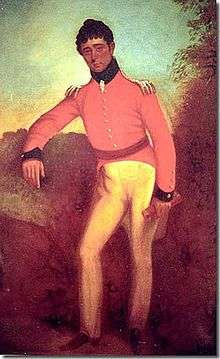
Royal Navy Rear-Admiral John Hindmarsh was selected to be South Australia's first governor. The first settlers and officials set sail in early 1836. A total of nine ships consisting of 636 people set sail from London for South Australia. The ships in the fleet included the Cygnet (carrying Colonel William Light's surveyors), Africaine,[10] Tam O'Shanter,[11] Rapid, and HMS Buffalo (carrying Hindmarsh).[12]
After an eight-month voyage around the world, most of the ships took supplies and settlers to Kangaroo Island. They landed at Kingscote to await official decisions on the location and administration of the new colony.
Surveyor Colonel William Light was given two months to locate the most advantageous location for the main colony. He was required to find a site with a harbour, arable land, fresh water, ready internal and external communications, building materials and drainage. Light rejected potential locations for the new main settlement, including Kangaroo Island, Port Lincoln and Encounter Bay. Light decided that the Adelaide plains were the best location for settlement.
Most of the settlers were moved from Kangaroo Island to Holdfast Bay with Governor Hindmarsh arriving on 28 December 1836 to proclaim the province of South Australia.[12] The Port River was sighted and deemed to be a suitable harbour, but there was no fresh water available nearby.
The River Torrens was discovered to the south and Light and his team set about determining the city's precise location and layout. The survey was completed on 11 March 1837. Light's poorly paid and ill-equipped surveying team were expected to begin another massive task of surveying at least 405 km2 of rural land. Light, despite slowly succumbing to tuberculosis, managed to survey 605.7 km2 by June 1838.
Most other colonies had been founded by Governors with near total authority. In South Australia power was initially divided between the Governor and the Resident Commissioner so that government could not interfere with the business affairs or freedom of religion of the settlers. Relations between Hindmarsh and the Resident Commissioner quickly broke down.
Expansion of the colony
Until 1851, the Governor ruled with the assistance of an appointed Executive Council of paid officials. Land development and settlement was the basis of the Wakefield vision. Land law and regulations governing it were fundamental to the foundation of the Province and allowed for land to be bought at a uniform price per acre (regardless of quality), with auctions for land desired by more than one buyer, and leases made available on unused land. Proceeds from land were to fund the Emigration Fund to assist poor settlers to come as tradesmen and labourers.[13]
Agitation for representative government quickly emerged.[14] Most other colonies had been founded by Governors with near total authority, but in South Australia, power was initially divided between the Governor and the Resident Commissioner, so that government could not interfere with the business affairs or freedom of religion of the settlers. From 1843 to 1851, the colony was governed by a legislative council of seven appointed members. By 1851 the colony was experimenting with a partially elected council, with 16 of 24 members of the South Australian Legislative Council being elected that year and the remainder appointed.[15]
First agriculture: Sheep, wheat and wine
The first sheep and other livestock in South Australia were brought in from Tasmania. Sheep were overlanded from New South Wales from 1838, with the wool industry forming the basis of South Australia's economy for the first few years. Vast tracts of land were leased by "Squatters" until required for agriculture. Once the land was surveyed it was put up for sale and the Squatters had to buy their runs or move on.
Most bought their land when it came up for sale, disadvantaging farmers who had a hard time finding good and unoccupied land. Farms took longer to establish than sheep runs and were expensive to set up. Despite this by 1860 wheat farms ranged from Encounter Bay in the south to Clare in the north.
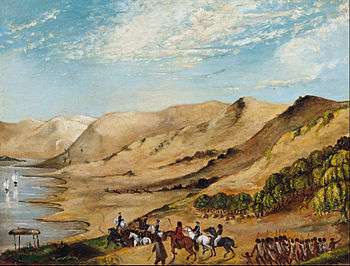
In 1840, the brigantine Maria was shipwrecked near Cape Jaffa after leaving Port Adelaide for Hobart.[16] All 25 people aboard were massacred by Aborigines along the Coorong.[16]
The wine growing regions of McLaren Vale and the Barossa Valley were established in the 1840s. Port Pirie was founded in 1845.
Copper was discovered near Kapunda in 1842. In 1845 even larger deposits of copper were discovered at Burra which brought wealth to the Adelaide shopkeepers who invested in the mine. John Ridley invented a reaping machine in 1843 which changed farming methods throughout South Australia and the nation at large. By 1843, 93 km2 of land was growing wheat (compared to 0.08 km2 in 1838). Toward the end of the century South Australia would become known as the "granary of Australia".
Gold discoveries in Victoria in 1851 brought a severe labour shortage in Adelaide which was created by the exodus of workers leaving to seek their fortunes on the goldfields. However, this also created high demand for South Australian wheat. The situation improved when prospectors returned with their gold finds.
During the 1850s over 5,400 hard working Germans settled in South Australia. Many started off the wine industry in the Barossa Valley and they opened the first Lutheran church in Hahndorf.
South Australians were keen to establish trade links with Victoria and New South Wales, but overland transport was too slow. A £4,000 prize was offered in 1850 by the South Australian government for the first two people to navigate the River Murray in an iron steamboat as far as its junction with the Darling River. In 1853 William Randell of Mannum and Francis Cadell of Adelaide, unintentionally making the attempt at the same time, raced each other to Swan Hill with Cadell coming in first.

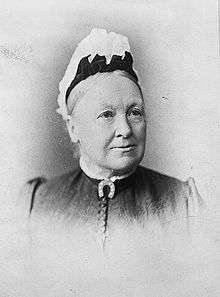
By the mid 19th century, there was a strong desire for representative and responsible government in the colonies of Australia. In 1840, the Adelaide City Council was established as the first city council in the Australian colonies. The Australian Colonies Government Act [1850] was a landmark development which granted representative constitutions to New South Wales, Victoria, South Australia and Tasmania and the colonies enthusiastically set about writing constitutions which produced democratically progressive parliaments with the British monarch as the symbolic head of state.[17] In 1850 and elections for legislative councils were held in the colonies of Victoria, South Australia and Tasmania.[18]
In 1855, limited self-government was granted by London to New South Wales, Victoria, South Australia and Tasmania. An innovative secret ballot was introduced in Victoria, Tasmania and South Australia in 1856, in which the government supplied voting paper containing the names of candidates and voters could select in private. This system was adopted around the world, becoming known as the "Australian Ballot". 1855 also saw the granting of the right to vote to all male British subjects 21 years or over in South Australia.
In 1877, it became the first part of the British Empire to legalise Trade Unions and in 1891, four United Labor Party candidates were elected to Parliament, becoming the first endorsed Labor members in Australia.[19]
Further copper discoveries were made in 1859 at Wallaroo and in 1861 at Moonta.
South Australia was a haven for religious refugees leaving Europe over this period. German Lutherans established the influential Hermmannsberg Mission in Central Australia in 1870.[20] David Unaipon who was to become a preacher and Australia's first Aboriginal author was born at Point McLeay Mission in South Australia in 1872. The son of Australia's first Aboriginal pastor, he is today honoured on the Australian $50 note.
Saint Mary Mackillop co-founded the Sisters of St Joseph of the Sacred Heart in rural South Australia in 1866. Dedicated to the education of the children of the poor, it was the first religious order to be founded by an Australian. Mackillop established schools, orphanages and welfare institutions throughout the colonies. She became the first Australian to be honoured by canonisation as a saint of the Roman Catholic Church in 2010.[21]
During John McDouall Stuart's 1862 expedition to the north coast of Australia he discovered 200,000 km2 of grazing territory to the west of Lake Torrens and Lake Eyre. Stuart succeeded in traversing Central Australia from south to north. His expedition mapped out the route which was later followed by the Australian Overland Telegraph Line.[22] South Australia was made responsible for the administration of the Northern Territory, which was previously part of New South Wales.
In the 1890s Australia was affected by a severe economic depression. Financial institutions in Melbourne and banks in Sydney closed. The national fertility rate fell and immigration was reduced to a trickle. The value of South Australia's exports nearly halved. Drought and poor harvests from 1884 compounded the problems with some families leaving for Western Australia. Adelaide was not as badly hit as the larger gold-rush cities of Sydney and Melbourne, and silver and lead discoveries at Broken Hill provided some relief.
Self-governing colony (1856)
South Australia became a self-governing colony in 1856 with the ratification of a new constitution by the British parliament. A bicameral parliament was elected on 9 March 1857, by which time 109,917 people lived in the province.
South Australia's 1856 constitution was among the most democratic in the world – more so than the other Australian colonies, the United Kingdom and most European countries at that time. It provided for: Adult male suffrage (including indigenous men); Secret ballot voting; one man, one vote; no property qualifications for Members of its House of Assembly and a relatively low property qualification for Members of its Legislative Council.[19]
Propertied women in the colony of South Australia were granted the vote in 1861. In the Constitutional Amendment Act 1894, all women became eligible to vote for the Parliament of South Australia when they won the same voting rights as men, and they did so in South Australia's 1895 elections.[23]
The Constitutional Amendment Act 1894 was also the first legislation in the world permitting women also to stand for election to political office and, in 1897, Catherine Helen Spence became the first female political candidate for political office, unsuccessfully standing for election as a delegate to the Federal Convention on Australian Federation.[24][25]
By the 1890s, several new factors were drawing the Australian colonies towards political union and South Australians voted by referendum to join the Commonwealth of Australia.
Twentieth century
On 1 January 1901, following a proclamation by Queen Victoria, South Australia ceased to be a self-governing colony and became a state of the Commonwealth of Australia. In 1906, South Australia's first uranium mine was opened at Radium Hill.[26] In 1910, the government of John Verran served as the first complete Labor party government in the world.[27]
28,000 South Australians volunteered to fight during Australia's involvement in the First World War. Adelaide enjoyed a post-war boom but with the return of droughts, entered the depression of the 1930s, later returning to prosperity with strong government leadership. Secondary industries helped reduce the state's dependence on primary industries. The 1933 census recorded the state population at 580,949, which was less of an increase than other states due to the state's economic limitations.
After the second world war, the Woomera rocket range was established in 1947 as part of the Anglo-Australian Joint Project – at that time one of only four rocket ranges in the world. Busy through the 1950s, Woomera played an important role in the development of space technologies.[28] With US assistance, Wresat 1, the first Australian satellite, was launched from Woomera, in November 1967 – a joint project of the Weapons Research Establishment and the University of Adelaide. The project made Australia only the 4th country to launch its own satellite from its own territory – and a landmark in Australian science.[29]
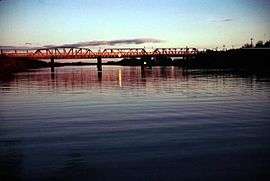
Rocket launches largely ceased from the early 1970s, though some space related activity has continued into the 21st century and the base is now controlled by the Royal Australian Airforce.[30] The University of Adelaide has a long history of scientific research and scholarship of international significance, and five Nobel Laureates have been associated with the University: Sir William Henry Bragg (Physics 1915); Sir William Lawrence Bragg (Physics 1915); Sir Howard Walter Florey (Physiology or Medicine 1945); J. M. Coetzee (Literature 2003); Robin Warren (Physiology or Medicine 2005).[31]
After World War II, an assisted migration scheme brought 215,000 emigrants of all nationalities to South Australia between 1947 and 1973. Murray Bridge, earlier known as Mobilong and then Edward's Crossing, was given its current name in the 1920s. It is now the fourth most populous region in South Australia, preceded by Adelaide, Mount Gambier and Whyalla.
The 1960s and 1970s saw the introduction of a series of landmark Australian legislative "firsts" in South Australia, including: the 1966 Prohibition of Discrimination Act, which prohibited discrimination on the grounds of race, colour, or country of origin; and 1975 The Sex Discrimination Act, which made discrimination on the grounds of gender, marital status, or sexuality unlawful. In 1975 Parliament "decriminalised" homosexual acts; and in 1976 rape in marriage was made a criminal offence.[27]
Construction of the Adelaide Festival Centre began in 1970 and South Australia's Sir Robert Helpmann became director of the Adelaide Festival of Arts.[32][33] The South Australian Film Corporation (SAFC) was established by the Don Dunstan government in 1972 and played a significant role in the revival of Australian cinema, with such critically acclaimed works as Picnic at Hanging Rock and Breaker Morant.
In 1976, the Pitjantjatjara Land Rights Act gave the Pitjantjatjara and Yankunytjatjara Aboriginal peoples inalienable freehold title over 100,000 km of their land.[27] That same year, South Australia appointed the first Aboriginal governor of an Australian state when Sir Douglas Nicholls was made Governor of South Australia.[34]
In 1987, copper, gold, and silver production began at the Olympic Dam mine. Olympic Dam also possesses the world's largest known deposit of uranium.
During the commercial property boom of the 1980s the State Bank of South Australia was the fastest growing bank in Australia – but in 1991, the bank collapsed and Labor Premier John Bannon announced that, due to bad debts, the bank would have to be rescued by the taxpayers – subsequently, the bank's book debt rose to $3 billion. A Royal Commission was called and Premier Bannon resigned after appearing before it.[35]
See also
References
- ↑ Geoffrey Blainey; A Very Short History of the World; Penguin Books; 2004; ISBN 978-0-14-300559-9
- ↑ Marwick, Ben; Hiscock, Peter; Sullivan, Marjorie; Hughes, Philip (July 2017). "Landform boundary effects on Holocene forager landscape use in arid South Australia". Journal of Archaeological Science: Reports. doi:10.1016/j.jasrep.2017.07.004.
- ↑ Gibbney, H. J. Sturt, Charles (1795–1869). Australian Dictionary of Biography. National Centre of Biography. Australian National University. Retrieved 21 March 2012.
- ↑ Sturt, Charles (1834). Two expeditions into the interior of southern Australia : during the years 1828, 1829, 1830, and 1831 : with observations on the soil, climate, and general resources of the colony of New South Wales (2nd ed.). London: Smith, Elder. p. 230.
- ↑ Sturt, Charles (1834). Two expeditions into the interior of southern Australia : during the years 1828, 1829, 1830, and 1831 : with observations on the soil, climate, and general resources of the colony of New South Wales (2nd ed.). London: Smith, Elder. p. 246.
- ↑ South Australia Act, or Foundation Act, of 1834 (UK). Documenting a Democracy. Retrieved 11 May 2016.
- ↑ Letters Patent establishing the Province of South Australia 19 February 1836 (UK). Documenting a Democracy. Retrieved 11 May 2016.
- ↑ South Australian Association, South Australia: Outline of the Plan of a Proposed Colony to be Founded on the South Coast of Australia, London, Ridgway, 1834, p.6
- ↑ Henry Capper and William Light, South Australia: Extracts from the Official Dispatches of Colonel Light, ... letters of settlers ... [and] the proceedings of the South Australian Company, London, H. Capper, 1837, p.21.
- ↑ Africaine, boundforsouthaustralia.com.au
Africaine (Barque ) - Colonists to South Australia in 1836, www.geni.com - ↑ Tam O'Shanter, boundforsouthaustralia.com.au
- 1 2 Kerr, Margaret Goyder Colonial Dynasty Rigby Limited, Adelaide 1980 ISBN 0 7270 1097 2
- ↑ South Australian Commission Land Sale Regulations 1835 (issued by the Commissioners in the UK) Archived 2 June 2011 at the Wayback Machine.. Documenting a Democracy. Retrieved 21 March 2012.
- ↑ 1834-1851 - Colonial Government. Parliament of South Australia. Retrieved 21 March 2012.
- ↑ Legislative Council 1843-1856. Parliament of South Australia. Retrieved 21 March 2012.
- 1 2 "A Famous Wreck". The Evening News. Sydney: National Library of Australia. 5 October 1895. p. 1 Supplement: Evening News Supplement. Retrieved 29 May 2013. This reference quite credibly states the bodies were stuffed down wombat holes, where others coyly refer to "shallow graves". It is also one of the few to touch on the contentious possibility of cannibalism.
- ↑ The Right to Vote in Australia. Australian Electoral Commission. Retrieved 21 March 2012.
- ↑ (28 January 2011). Australia’s major electoral developments Timeline: 1788 - 1899. Australian Electoral Commission. Retrieved 21 March 2012.
- 1 2 Democracy and human rights in the 19th century. Parliament of South Australia. Retrieved 21 March 2012.
- ↑ Nic Klaassen. "Hermannsburg Aboriginal mission on the Finke River Northern Territory". Retrieved 21 April 2011.
- ↑ (20 December 2009). MacKillop to become Australia's first saint. ABC News. Australian Broadcasting Corporation. Retrieved 21 March 2012.
- ↑ Tim Flannery; The Explorers; Text Publishing 1998
- ↑ cavanpe (9 March 2011). "Women's Suffrage Petition 1894" (PDF). Retrieved 16 August 2018.
- ↑ "AEC.gov.au". AEC.gov.au. 25 October 2007. Retrieved 27 June 2010.
- ↑ Constitution (Female Suffrage) Act 1895 (SA) Archived 3 December 2010 at the Wayback Machine.. Documenting a Democracy. Retrieved 21 March 2012.
- ↑ "Welcome". Radium Hill Historical Association. Archived from the original on 12 June 2009. Retrieved 27 July 2009.
- 1 2 3 Democracy and human rights in the 20th century. Parliament of South Australia. Retrieved 21 March 2012.
- ↑ (18 July 2007). Woomera recognised for historic value. ABC Science. Australian Broadcasting Corporation. Retrieved 21 March 2012.
- ↑ (29 November 2007).40th anniversary of Australia's first satellite. University of Adelaide. Media Release. Retrieved 21 March 2012.
- ↑ Denise Chow (26 March 2010). New Hypersonic Rocket Test Launched in Australia. space.com. TechMediaNetwork.com. Retrieved 21 March 2012.
- ↑ (25 October 2011). Nobel Laureates. The University of Adelaide. Retrieved 21 March 2012.
- ↑ History Archived 29 May 2010 at the Wayback Machine.. Adelaide Festival Centre. Retrieved 21 March 2012.
- ↑ Sir Robert Helpmann – a Knight to Remember Archived 17 February 2011 at the Wayback Machine.. Helpmann Awards. Retrieved 21 March 2012.
- ↑ Sir Douglas Nicholls Archived 3 June 2016 at the Wayback Machine.. Civics and Citizenship Education. Retrieved 21 March 2012.
- ↑ Jonathan Wright (29 May 2008). Top 10 Financial Moments That Shaped SA Archived 10 March 2014 at the Wayback Machine.. Retrieved 21 March 2012.
Bibliography
- Susan Marsden 'South Australia' in G Davison, J Hirst, S MacIntyre, eds, The Oxford Companion to Australian History, Oxford University Press, Melbourne (1998) ISBN 0-19-553597-9
- Elizabeth Kwan Living in South Australia: A Social History Volume 1:From Before 1836 to 1914 (1987)
- Derek Whitelock Adelaide: From Colony to Jubilee (1985)
- Dorothy Jauncey, Bardi Grubs and Frog Cakes — South Australian Words, Oxford University Press (2004) ISBN 0-19-551770-9